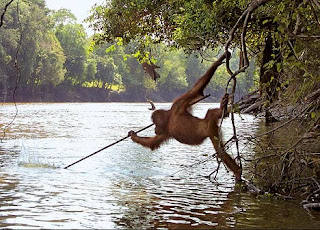True Wild Life | Orang Utan | The orangutan is now an endangered species. The orangutan is a large primate found naturally in the jungles of Borneo and Sumatra. There are an estimated 70,000 orangutan left in the wild and it is suspected that if nothing is done to prevent the rapidly diminishing population of the orangutan, then the orangutan will be extinct within the next 10 years. The orangutan are well known for their intelligence, long arms and orange hair. The orangutan is one of the more intelligent primates along with the gorilla, chimpanzee and the human.
The orangutan is the state animal and emblem for the Malaysian state of Sabah, Borneo. The orangutans name comes from the Malay and Indonesian phrase orang hutan meaning man of the forest. An estimated 5,000 orangutans are killed every year due to the destruction of the rainforest to make way for the ever increasing palm oil plantations (palm oil is a type of vegetable oil that is found in a shockingly large number of consumer products both food and cosmetics). Many baby orangutans are left orphaned when their mother orangutan is killed during the destruction of their jungle environment. A baby orangutan cannot look after itself effectively particularly when the orangutan has not been taught the vital skills it needs to survive.
The orangutan is an omnivore although they have an almost exclusively vegetarian diet. The orangutan eats fruit and berries and a wide variety of plants that grow in the tropics but mainly those that grow in the high forest tree tops making the orangutan a master of tree climbing.
Orang-utan Foot Facts
* The hands and feet of the orangutan are very similar to those of a human as they each have four longer digits (fingers and toes) and one opposable digit (thumb and big toe).
* The orangutan uses its complex hands and feet to grasp and hold things such as food and tree branches.
* The orangutan mainly uses its long arms and hands to climb trees with the feet of the orangutan acting to help support the body weight and balance of the orangutan.
* Instead of mainly using its legs and feet to get around, the orangutan primarily moves about using its hands and arms backed up by the incredibly strong shoulder muscles of the orangutan.
* The orangutan has finger and toe nails rather than claws which the orangutan mainly uses for opening fruit and scratching and cleaning itself.
* The orangutan often uses its mouth to as a place to store food so that the orangutan has free hands and feet for climbing and swinging in the trees.
* The orangutan has a powerful jaw that is capable of crushing on chewing its food, which includes spiky fruits, nuts and tree bark.
* The orangutan uses its lips to detect the texture of the food before eating it, and also for making facial expressions when communicating with another orangutan.
* Inside the mouth of the orangutan there are 32 teeth, which is the same number of teeth that a human has.
* The orangutan has teeth very much like the teeth of a human as the teeth of the orangutan are also coated in a thick layer of enamel in order to protect them and make them stronger.





1 comment:
this is awesome
Post a Comment